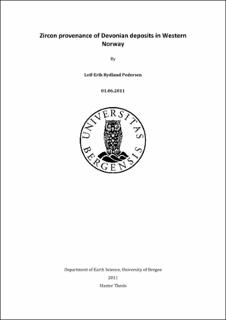Zircon provenance of Devonian deposits in Western Norway
Master thesis
Permanent lenke
https://hdl.handle.net/11250/3082568Utgivelsesdato
2011-06-01Metadata
Vis full innførselSamlinger
- Master theses [106]
Sammendrag
The provenance of the Devonian deposits of western Norway has been studied by detrital zircon geochronology. These deposits are found in the Fensfjorden -, Solund -, Kvamshesten -, Hornelen - and Smøla basin. A total of 9 samples were collected, and extracted for detrital zircons (n = 713), which were analyzed with laser ablation ICP-MS to determine their U/Pb age.The detrital U/Pb zircon ages provide three distinct groups: ~400-500 Ma, 900-1200 Ma, and 1400-1700 Ma, which are correlated rocks formed during Caledonian, Sveconorwegian, and Gothian orogeny, respectively.The zirkon population of the samples from the Fensfjorden and the Solund basins, which are the two southernmost basins, are dominated by Sveconorwegian zircons. The Lindås Nappe (Middle Allochthon) appears to be the most likely source of these zircons. To the north there is a marked change to more Gothian zircons in the Kvamshesten basin. This is consistent with the Gothian ages reported from the Middle Allochthon in this area (the Dalsfjord Suite). Assuming that the Middle Allochthon is the main source of the Proterozoic zircons of these basins, then this supports a marked change in the ages of the Middle Allochton form an Sveconorwegian-dominated Lindås Nappe in the south - to a Gothian-dominated Dalsfjord Nappe towards the north.In the Hornelen and Smøla basins there are a large component of Caledonian zircons with the Upper Allochthon as a main source. In the Hornelen basin in particular, there is a population of zircons with a young Caledonian age (410 - 415 Ma). Potential source rocks for this component is as yet only reported from the Middle/Lower Allochthons in the footwall of the Nordfjord-Sogn Detachment Zone and from the Western Gneiss Region.
